Dec 2013
Dec 2013 sadmin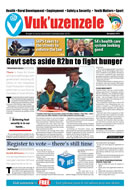
Govt sets aside R2bn to fight hunger
Govt sets aside R2bn to fight hunger sadminThere is hope for those who go to bed hungry, with government allocating R2 billion to the Integrated Food Production Initiative, which aims to put food on the tables of South Africans.
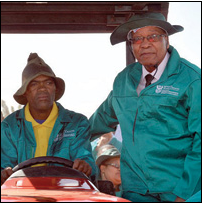 The funds have been set aside to support Fetsa Tlala (End Hunger) programme, an initiative President Jacob Zuma officially launched in Batlharos, outside Kuruman in the Northern Cape, recently.
The funds have been set aside to support Fetsa Tlala (End Hunger) programme, an initiative President Jacob Zuma officially launched in Batlharos, outside Kuruman in the Northern Cape, recently.
The programme, aimed at producing enough food to meet the population’s needs, is an approach by government, involving a number of sectors, to deal with the problem of food insecurity.
“We are making R2 billion available for this programme as part of comprehensive support to farmers and for distribution to provinces. The initiative intends to put one million hectares of land under production of maize, beans and potatoes,” President Zuma said.
Government will help small-scale and smallholder producers put at least one million hectares of arable land across the country under production by 2019.
The President said through Fetsa Tlala, government also wanted to shift perceptions about agriculture and farming in general.
He said the impression that agriculture was not as important as other sectors was wrong.
Agriculture is a key priority for government, as it forms part of the six job drivers identified in the New Growth Path.
The other five are mining, tourism, the green economy, manufacturing and infrastructure development.
According to President Zuma, this demonstrates the seriousness government has attached to agriculture for food security, job creation and economic development.
He said through Fetsa Tlala, all underutilised agricultural land must be put under production.
“We are encouraging people to go back to farming. We are encouraging every household to establish a food garden. We want to see women’s cooperatives and community groupings focusing on vegetable production, livestock or chickens to earn a living and fight hunger and poverty.”
The Fetsa Tlala initiative is already active in the Eastern Cape and Limpopo while plans are underway to extend it to other provinces.
Food insecurity
President Zuma - who also visited the Manyeding Agricultural Cooperative project, which is playing a role in fighting hunger and food insecurity in villages east of Kuruman - was encouraged that the overall food insecurity figure was declining due to government programmes.
The cooperative, which has a total of 159 beneficiaries from Manyeding and surrounds, is situated on a 137-hectare land. It produces organic vegetables such as potatoes, tomatoes, spinach, green beans, cabbage and pumpkin.
Since the start of the cooperative in 2010, many jobs have been created for the locals. The cooperative supplies fresh produce to Pick n Pay, Boxer and Spar supermarkets.
However, the President noted that families still lived in poverty and the country remained a net importer of food, instead of being a major food producer.
Maximising land
According to the President, a significant amount of land still lies bare, especially in rural areas and some acquired through land reform.
He said smallholder farmers, communities and households would be assisted through the provision of mechanical equipment and distribution of production inputs and technical services.
Much of the worst poverty is concentrated in the former homelands. The homelands, which accounted for 13 per cent of the country’s land, were home to half of the black population in South Africa before 1994.
These areas are still characterised by low incomes and high rates of infant mortality, malnutrition and illiteracy.
“These areas have remained extremely poor and underdeveloped, and are heavily dependent on remittances from workers in industrial South Africa,” President Zuma said.
He said South African agriculture continued to be characterised by a racially skewed distribution of assets, support services, market penetration, infrastructure and income.
“Some 36 000 large-scale farmers control over 86 million hectares of farmland, while 1.4 million black farmers have access to about 14 million hectares of farmland,” he pointed out.
The President was confident that by working together South Africans could fight hunger.
“Achieving food security is in our hands, all of us. We must get back to the land and start working to produce food,” he stressed.
Register to vote – there’s still time
Register to vote – there’s still time sadminSouth Africans who have not yet registered to vote in next year’s election still have the opportunity to do so.
 Those who did not take advantage of the Independent Electoral Commission’s (IEC) recent registration drive by registering at voting stations can register at their local municipal electoral office during office hours.
Those who did not take advantage of the Independent Electoral Commission’s (IEC) recent registration drive by registering at voting stations can register at their local municipal electoral office during office hours.
If you choose to register at a municipal electoral office make sure you phone first to arrange a time.
Remember, you can’t register at the IEC’s national or provincial offices, only municipal offices.
The IEC has also announced that there will be a final registration weekend on 8 and 9 February 2014.
To find the correct voting station or municipal electoral office where you can register, call the IEC on 0800 118 000.
You only have to register once as a voter, unless you move or your voting district changes.
To qualify as a voter, you must be a South African citizen, be at least 16 years old and have a green, barcoded ID book or smart ID card.
You only have to reregister when your home address changes or the IEC informs you that the voting district has changed.
By law, you must apply for registration in person.
The IEC advises that take along your green, bar-coded ID book, smartcard ID, or temporary identity certificate if you don’t have an ID book.
It can take up to seven working days for your registration application to be processed.
To check your registration status, you can:
- Send an SMS with your ID number to 32810.
- Check your voter registration details online.
- Call the IEC call centre on 0800 118 000.
- Check at your local municipal electoral office during office hours.
President Zuma pleased with E Cape projects
President Zuma pleased with E Cape projects sadminInfrastructure
Mthatha is a developing city with good prospects of competing against established cities like Johannesburg in the future.
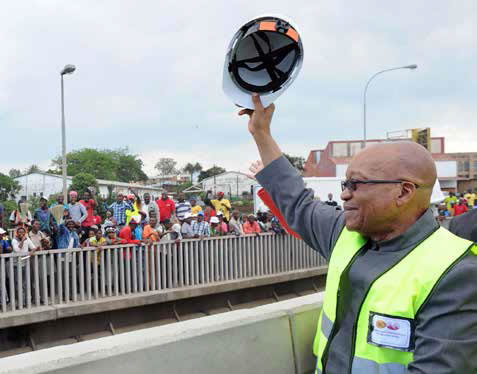 This is according to President Jacob Zuma, who recently launched the multi-million rand infrastructure upgrades in the King Sabata Dalindyebo Municipality of the Eastern Cape.
This is according to President Jacob Zuma, who recently launched the multi-million rand infrastructure upgrades in the King Sabata Dalindyebo Municipality of the Eastern Cape.
The projects the President unveiled cut across water, electricity, roads and transport. President Zuma said while there had been challenges that had caused delays in the delivery of services, government was committed to rolling out services to priority areas.
“Today, we came to inspect and officially launch infrastructure projects related to water, electricity, roads and transport. As you are aware, work is continuing to improve the infrastructure and the living conditions in Mthatha.
“We are also looking at improving housing but are constrained by the land issue, which has not been resolved yet. Today’s programme demonstrates government’s seriousness in extending services that improve lives,” he said.
The President’s visit was markedly different to the one in 2010, when he was not impressed with the progress made when he evaluated several infrastructure projects in the area.
“In 2010, I visited this area and was disappointed by the condition of infrastructure in King Sabata Dalindyebo (municipality) and the fact that Mthatha and surroundings appeared to be in a state of collapse,” he recalled.
This time around, he unveiled several projects, including the completion of the Thornhill substation, which was upgraded at a cost of R40 million.
Government has invested millions of rands to provide electricity to the area and almost 3 000 new electricity connections have been made.
“Over the last two years, a total amount of R251 million was spent in the (municipality) for network upgrading and strengthening of networks to ensure better quality of (electricity) supply,” he said.
The project created 125 jobs.
President Zuma also officially re-opened Mthatha Bridge, which was expanded at a cost of R108 million to ease traffic congestion and travelling time to town.
He also said government had put out a R200 million tender to upgrade Mthatha Airport. Planned improvements include building a new car hire facility with a separate parking area and wash bay; a new security fence around the whole airport, with a parallel security road with lighting; heightening the control tower; landscaping around the new terminal building and the renovation of the existing cargo building.
“A new runway has been constructed and the airport will be able to receive larger aircraft, which will unlock the economic potential of the region,” said President Zuma. He was also happy with progress made in the construction of two reservoirs at the Mthatha water treatment plant.
President Zuma said several other electricity grid upgrades and electricity connections to households had created hundreds of jobs in the area.
“Government has prioritised electricity provision in the least electrified provinces of KwaZulu-Natal, Limpopo and the Eastern Cape, focusing specifically on the building of network capacity in these provinces to support additional connections.”
Efforts were underway to improve infrastructure and the living conditions in Mthatha, he added.
“A lot has been achieved already in 19 years and much more is still being done,” said the President.
* Yolisa Manxiwa works for GICS in the Eastern Cape.
Renewable energy powers SA to cleaner future
Renewable energy powers SA to cleaner future sadminInfrastructure
South Africa is taking s teps to produce renewable energy to meet its increasing energy needs and reduce its reliance on coal-powered power stations.
 Energy is the fuel we use in our daily lives. We use petrol or diesel to fill up our cars and gas or electricity to cook our food. However, these energy sources are in great demand, cost a lot and take a long time to manufacture.
Energy is the fuel we use in our daily lives. We use petrol or diesel to fill up our cars and gas or electricity to cook our food. However, these energy sources are in great demand, cost a lot and take a long time to manufacture.
With more than 50 million people living in South Africa, more and more energy is needed, and if other energy sources are not used, the country could face a severe shortage of energy.
Renewable energy is made from natural resources such as plants, sunlight, wind, waves and geothermal heat.
The Department of Energy (DoE), as part of its renewable energy strategy, has set a target to create 10 000GWh (Gigawatt hours) of energy from renewable energy sources by the end of this year. This amount of energy would be enough to cover the electricity used by about 2.2 million homes for a year.
To help boost and create renewable energy, Eskom established new power stations throughout the country. The DoE estimates that these new renewable energy projects will contribute almost R1 billion to the country’s revenue each year, create over 20 000 new jobs and save almost 16.5 million kilolitres of water, which will in turn save government almost R26 million a year.
Solar power on the rise
Construction of the country’s first two Concentrated Solar Power (CSP) stations is also underway. Khi Solar One and KaXu Solar One in the Northern Cape will be able to draw enough energy to supply electricity to the country’s national grid at critical times.
Khi Solar One is a 50MW power tower plant in Upington that will use large sun tracking mirrors called heliostats to direct sunlight onto a receiver at the top of the tower. Water is then pumped up the tower and is converted into steam, which is used in a conventional turbine generator to produce electricity. The power station will also include a steam storeroom that can generate electricity when the sun is not shining.
The plant will prevent about 183 000 tons of carbon emissions each year and will create almost 600 jobs during construction and a further 35 once the plant is up and running.
KaXu Solar One will be a 100MW parabolic trough plant near Pofadder and will use salt to store heat energy. The parabolic trough system simply means that the sun’s energy will be received by parabolically curved, trough shaped reflectors.
The energy will heat oil fl owing through the pipe. The heat energy is then used to convert water into steam to generate electricity in a conventional steam generator. About 800 jobs will be created during construction, with an additional 35 created during operation. KaXu Solar One will prevent 315 000 tons of carbon emissions each year.
South Africa will also introduce a third CSP called the Bokpoort CSP in the province. The R4.5 billion power station will be built in the near future.
According to the Northern Cape Department of Economic Development and Tourism, the town of Prieska is now home to the country’s first ever solar park. Phase 1 of the development aims to produce 1GWh of energy by 2018. Government has also completed the 75MW Kalkbult solar farm in De Aar in the Northern Cape and is well on its way of installing almost 17 800MW of renewable energy by the end of 2030.
New power stations
Medupi Power Station is being built in Lephalale, Limpopo, as a new dry-cooled, coal-fired power station. South Africa can expect electricity next year from Medupi, which will have six boilers powering 794MW units to produce over 4 764MW of power, enough to supply the electricity needs of about 1 000 homes for a year, by June 2014.
The Kusile Power Station in Mpumalanga is the second coal-fired power station built as part of government’s infrastructure expansion programme.
Kusile's first unit will start producing electricity as from December 2014.
In total Kusile has six 800MW units, with the remaining units scheduled for completion in 2017.
The R121 billion third power station, Ingula, is being built on the border of the Free State and KwaZulu-Natal.
Public Enterprises Minister Malusi Gigaba stressed that government was committed to meeting the electricity demand in the country.
“We are confident that we can turn things around with the measures and strategies we have put in place to make sure that electricity supply capacity grows to meet rising demand as our country pursues its growth rate targets,” he said.
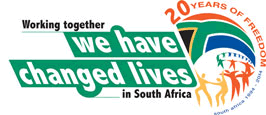 About 180 000 people have found work through the government's infrastructure programme.
About 180 000 people have found work through the government's infrastructure programme.- The largest single-site employment is Medupi Power Station which employs 17 000 people.
- Kusile Power Station is the second largest employer, employing 14 002 people.
Dept targets 365 days of road safety
Dept targets 365 days of road safety sadminThe Department of Transport has been hard at work introducing state-ofthe- art transport facilities by upgrading road, rail and aviation infrastructure. Yet despite these world-class improvements, serious accidents continue to take place, leaving families devastated and the country poorer.
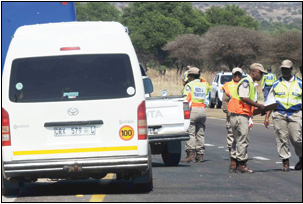 This is because many road users continue to be disrespectful, irresponsible and inconsiderate while on the roads. Transport Minister Dipuo Peters said road safety remained a huge concern for her department and government. To tackle this issue, the department introduced the 365 Days of Road Safety Programme recently.
This is because many road users continue to be disrespectful, irresponsible and inconsiderate while on the roads. Transport Minister Dipuo Peters said road safety remained a huge concern for her department and government. To tackle this issue, the department introduced the 365 Days of Road Safety Programme recently.
As part of the programme there will be more roadblocks, stop and goes, visible traffic monitoring and policing, as well as tougher measures against road users who misbehave, she said.
Traffic authorities will also continue to deal harshly with drunken driving, speeding, unsafe overtaking, overloading and driving unroadworthy vehicles.
“I am concerned that more people are killed on our roads despite the road safety campaigns and education that we carry out across the country every year. As a government we cannot do it alone,” said the Minister.
In 2009 government committed to the Millennium Development Goals, which include improving road safety and halving the number of road fatalities by 2015.
In 2001, about 11 201 people were killed in 8 802 accidents. From 1 December 2012 to 4 January 2013, 1 348 people were killed and 1 124 fatal accidents took place.
As a result, South Africa was ranked the worst out of 36 countries when it came to road fatalities, according to the International Transport Forum's (ITF) Road Safety Annual Report, released in May this year.
According to the Minister, the majority of the vehicles involved in crashes were not roadworthy.
“The long-term effects of road crashes are devastating. Breadwinners are taken away from their families. I do not take it lightly when transport operators pay lip service to vehicle roadworthiness and road safety as a whole.” As a result of these accidents, which could have been avoided, families are left to fend for themselves.
The department recently introduced Operation Kwanele: It's enough, in the Colesberg and Noupoort areas of the Northern Cape. Motorists and road users were educated and encouraged to heighten road safety awareness and take responsibility for their safety.
Despite the department implementing various road safety programmes, such as Operation Kwanele, the number of road fatalities is increasing and if the current trend continues, road crashes are predicted to become the leading cause of death by 2020.
The department also revealed that at least R306 billion was lost each year as a result of road crashes.
The cost included loss of manpower and skills due to fatalities and injuries, emergency medical services, post-crash services such as road repairs and clean-up operations and compensation paid out to victims.
The Road Accident Fund (RAF) alone pays out at least R15 billion to victims of road crashes each year. Of this amount, R1 billion is for continued medical support of the injured. Through its Community Outreach Programme, RAF on the Road, the fund is able to swiftly register and settle claims on location.
Law enforcement is also a crucial part of the 365 Days of Road Safety Programme, said the Minister.
Major challenges include unqualified drivers being issued with licences and unroadworthy vehicles being certified as roadworthy.
The safety campaign will aim to ensure that only learner drivers who have received adequate training will be booked for a driving licence test.
“No one should bypass processes to make extra revenue at the expense of people’s lives,” said the Minister.
In addition, the national Administrative Adjudication of Road Traffic Offences (Aarto) and its demerit points system would also be rolled out. Minister Peters said road safety wasn’t just the responsibility of government and drivers but also that of fleet owners, passengers and pedestrians.
Government is confident that its campaigns, will make an impact and the country’s roads.
End of the road for multiple IDs
End of the road for multiple IDs sadminTime is running out for South Africans who have duplicate identity documents (IDs).
If you share your identity number with somebody else or you have more than one ID number, you will not be able to use your ID from January 2014.
According to the Department of Home Affairs more than 40 000 South African’s IDs have been duplicated.
The department’s Director-General Mkuseli Apleni warned: “It is illegal for a person to share an ID with another or have multiple IDs.
”If you are one of those affected, you will not be able to open accounts, apply for a driver’s licence or do banking from 31 December 2013, when all ID numbers that are duplicates will be cancelled.”
If your identity document has been duplicated, visit your nearest Home Affairs office urgently to rectify it.
To find out if you have a duplicate ID, check your name on the Government Gazette or SMS the letter ‘D’ followed by your ID number to 32551. You can also visit the Home Affairs website www.dha.gov.za and follow the link ‘duplicate’ or call the toll free number 0800 601 190.
Help keep SA’s roads safe
Help keep SA’s roads safe sadminAs thousands of South Africans take to the roads over holidays, motorists have been warned to take extra care and stay out of trouble.
Road accidents and deaths, often involving pedestrians, are at their highest during the festive period, according to the Road Traffic Management Corporation (RTMC).
The RTMC has launched its festive season road safety campaign to crack down on bad driving, in keeping with the Decade of Action for Road Safety 2011-2020 campaign.
As part of the campaign, the RTMC has joined forces with the South African Police Service (SAPS), the South African National Roads Agency Limited (SANRAL), the Road Accident Fund (RAF) and toll concessionaires to police, manage, lead and coordinate smarter, ultimately ensuring safer roads.
This festive season authorities are aiming to stop and check one million cars across the country per month, as well as carry out at least 2 500 sobriety tests per province.
They will also crack down on drinking and driving, speeding, moving violations, unroadworthy vehicles, driver fatigue and pedestrian negligence.
Speeding, drinking and driving, unfit vehicles and not buckling up are the biggest contributors to road deaths and accidents, says Ashraf Ismail of the Law Enforcement Technical Committee (LETCOM), a subcommittee of the RTMC.
It is these offences authorities will be on the lookout for.
While the authorities are doing their bit, motorists have also been encouraged to play a role in ensuring their safety.
Transport Minister Dipuo Peters, together with the RTMC, has urged drivers to get their vehicles checked and ensure their tyres and brakes are in a roadworthy condition.
During the holidays many families take to the roads without first checking if their cars are safe to drive.
Road safety is not only a concern for drivers but pedestrians as well. Drinking and walking, jay walking and walking on freeways is against the law, Ismail warns.
More than 1 300 people died on the roads between 1 December 2012 and 4 January 2013 with 1 124 accidents taking place.
KwaZulu-Natal recorded the highest number of crashes with 226 in the same period, followed by Gauteng with 213, the Eastern Cape with 125 and Limpopo with 124 crashes. It was also found that over 80 per cent of the accidents involved young males between the ages of 19 and 34.
During that time, 220 enforcement operations were carried out throughout the country, more than 111 000 vehicles were stopped and checked and 2616 people were arrested.
Government has urged all road users to be smart and safe this festive season. Get there, no regrets.
SAPS takes to the streets to enforce the law
SAPS takes to the streets to enforce the law sadminAs South Africans take a much-needed break this festive season, the South African Police Service (SAPS) is out in full force to ensure the safety of all citizens.
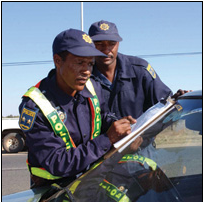 Speaking at the launch of the national Duty Calls Festive Season Operation in George recently, Police Minister Nathi Mthethwa said this year’s campaign would focus on crimes against vulnerable groups.
Speaking at the launch of the national Duty Calls Festive Season Operation in George recently, Police Minister Nathi Mthethwa said this year’s campaign would focus on crimes against vulnerable groups.
“This campaign centres around aggravated robberies, border security, illegal firearms, liquor and Second Hand Goods Act enforcement, by-law enforcement and road safety enforcement. This year in particular, we shall be having a concerted focus on crimes against women, children, persons with disabilities and the elderly,” said Minister Mthethwa.
The operations began in October and will end next month.
The Minister pointed out that every festive season, families came together to share a spirit of goodwill while robbery, murder and hijackings put a damper on this and created fear and anxiety.
Police would work hard to ensure that families had nothing to worry about and would be out on the streets keeping a close eye on holidaymakers, he added.
“We are also intensifying our partnership with society in the fight against crime as well as intensifying police visibility during the period.”
Efforts were also underway to ensure that people did not lose their hard-earned money.
“During this period there is an increased movement of large sums of money like individuals receiving their bonuses and stokvel associations withdrawing large savings as well as schools receiving admission funds.
“Such transactions and financial movements, unfortunately, also provide opportunities for criminals to commit crimes like bank robberies, cash in transit heists, ATM bombings, armed robbery and theft,” he warned.
Minister Mthethwa said government, working with communities, had put in place safety measures to prevent these crimes.
SAPS, as the lead agency of the National Joint Operational and Intelligence Structure (NATJOINTS), spearheads these operations, which aim to educate people about the rise in these crimes during the festive season.
Fight crime
He said police would be involved in a number of operations countrywide, interacting with communities, businesses and other organisations to fight crime.
Minister Mthethwa added that while police would deal with criminals, parents and guardians had to play a greater role in caring for and protecting children.
“Members of society, including children, must work together with law-enforcement agencies in combating abuse, neglect and exploitation of our children.”
He appealed to parents and communities to protect children against drug abuse, saying it could not be left to government alone.
“We want to say that young people, these criminals who sell you drugs, are not interested in your well-being. These drug lords are hell-bent on destroying your future. Do not get hooked because that will be the beginning of the destruction of your lives.”
Minister Mthethwa said once the youth were hooked on drugs, they turned to crime, such as burglaries and theft, to sustain their habit.
“When we passed the Second-Hand Goods Act … our intervention by and large was targeting such criminal acts. The Act stipulates that any person who buys stolen goods is as guilty as the person who stole the goods; and harsher sentences will apply to both the buyer and the thief.
“Now with the new law, both the buyer and the seller face a prison sentence of up to 10 years, which in the past was 10 months. This shows our resolve that perpetrators (must) face the wrath of the law,” he warned.
Meanwhile, National Police Commissioner General Riah Phiyega said she was pleased that the communities were partnering with SAPS in the fight against crime.
She noted that Community Police Forums were a vital link between the community and the police.
General Phiyega reminded South Africans about the 24-hour hotline – Crime Stop – they can call to report suspicious activities, including child neglect and abuse.
The Crime Stop number is 08600 10111.
Police do it by the book at new university
Police do it by the book at new university sadminThe South African Police Service (SAPS) has taken another step towards professionalising policing by establishing a university for cops.
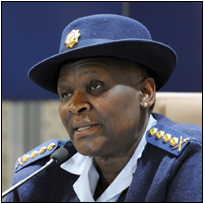 The SAPS University is being set up through a partnership between police and the University of South Africa (UNISA) after the two bodies recently signed agreements.
The SAPS University is being set up through a partnership between police and the University of South Africa (UNISA) after the two bodies recently signed agreements.
The agreements marked the first phase of setting up a police university, said National Police Commissioner General Riah Phiyega.
“The second phase, which will start early in 2014, will involve welcoming the first 120 police learners at the SAPS Academy in Paarl to start their studies towards a Bachelor of Policing Degree,” said General Phiyega.
She said the curriculum for this degree was already in place at UNISA and over time the curriculum for the full-time course could be tailored to suit SAPS’ developing needs.
The university is expected to play a role in transforming SAPS into a professional body with employees of integrity who will ensure a safer South Africa.
“By establishing our own university, where learners will wear their police uniforms during class and drill will be part of the curriculum, we will be combining academic studies with a culture of discipline, honesty and professionalism.
“By doing this we will be able to build future leaders for the police and establish a pool of excellence from which commanders can be selected in future to lead the organisation with integrity and loyalty.” She said prospective students would be chosen from members who have met a strict set of criteria.
“Their progression through the course will be carefully managed to ensure that only those whose values and morals are of the highest standard – and whose academic achievements are also up to expected set standard – graduate.”
General Phiyega said the aim was for the institution to become internationally respected.
“We want to attract police learners from the Southern African region, the African continent and other countries.
We also want to see an exchange of students so that our learners will also have the opportunity of studying policing in other countries.” The SAPS University will, to an extent, be modelled on the South African National Defence Force’s Military Academy in Saldanha Bay, which has been in existence for over 50 years, she said.
SA's health care system looking good
SA's health care system looking good sadminSteady doses of government intervention over the past 20 years have put South Africa’s health care system on a steady road to recovery, with citizens now enjoying longer, healthier lives.
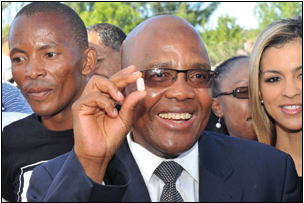 HIV infections have decreased, life expectancy increased, anti-retrovirals (ARVs) are freely available, and the National Health Insurance (NHI) promises greater access to health care for those who need it the most.
HIV infections have decreased, life expectancy increased, anti-retrovirals (ARVs) are freely available, and the National Health Insurance (NHI) promises greater access to health care for those who need it the most.
Over these past two decades, the national Department of Health has been hard at work, introducing and prioritising a number of initiatives to achieve these successes.
The department targeted four key areas to improve the health system, which included increasing life expectancy; decreasing maternal and child mortality; combating HIV and AIDS and decreasing the burden of disease from TB; and strengthening the effectiveness of the health system.
HIV and Aids
In 2009 President Jacob Zuma gave the country’s HIV and AIDS policies a facelift.
The President announced that all children under one year of age would get treatment if they tested positive and that treatment would not depend on the CD4 count.
All patients with both TB and HIV would get ARV treatment if their CD4 count was 350 or less.
In addition, pregnant HIV positive women with a CD4 count of 350 or with symptoms regardless of CD4 count would have access to treatment.
Previously HIV positive pregnant women were eligible for treatment if their CD4 count was less than 200.
All other pregnant women who did not fall into this category were to be put on treatment at 14 weeks of pregnancy to protect their babies. In the past this only started during the last term of pregnancy.
All these policies were to be effective from April 2010.
Also in 2009, the department announced the HIV Counselling and Testing (HCT) Campaign, which was to be the cornerstone for the prevention and early entry into ARVs.
According to the department by 2012, 1.6 million people were receiving ARVs and 20.2 million people had tested for HIV.
As part of the HCT campaign, government also introduced the male circumcision campaign and in 2012 alone, 619 000 males were circumcised.
According to the Department of Health’s 2012 Mid Term Review Report, the rate at which TB was being cured rose to 73 per cent.
This achievement has resulted from a combination of interventions, such as using the new Genexpert technology, which was introduced in 2011.
From March 2011 to February 2012, South Africa had conducted almost 300 000 Genexpert tests to detect the disease.
The report also notes the progress in reducing new HIV infections with the mother-to-child transmission rate dropping from 3.5 per cent in 2010 to less than two per cent in 2012.
In another development with regards to HIV and AIDS, Health Minister Aaron Motsoaledi officially launched the Fixed Dose Combination drug in April this year. With the new pill, patients take one tablet once a day instead of three to five.
Meanwhile, the South African National Aids Council (SANAC), recently announced that the country was making progress in the Millennium Development Goal set by the United Nations of reducing HIV infections by half by 2015.
South Africa’s Anti-Retroviral Treatment Programme now reaches more than two million people, making it the largest HIV treatment programme in the world.
In addition, Deputy President Kgalema Motlanthe announced at the 6th Aids Conference recently that the number of HIV-related deaths reported had decreased from 613 108 in 2006 to 543 856 in 2010.
Most researchers, as well as Statistics South Africa (Stats SA), have attributed this decline to the distribution and use of condoms as well as the ARV programme.
South Africans are also enjoying longer lives, according to statistics.
Stats SA’s 2013 mid-year population estimates shows that life expectancy increased from 52 years in 2004 to 58 years in 2011 and is estimated to have increased further, to just under 60 years (or 59.4 years) in the 2013 estimates – with life expectancy of women at 61 years and men at 58.
Government can also channel more money to the country’s HIV and TB programmes after getting R3 billion from the Global Fund to support these.
The fund will provide support in:
- ARV treatment for 350 000 patients.
- HIV testing for more than a million people, including people living in rural areas and on farms.
- Full screening for TB of all inmates at 258 correctional services facilities.
- Screening for more than 400 000 miners and communities around mines.
- Prevention and referral services for 33 000 sex workers in all nine provinces.
- Prevention and referral services for 150 000 men who have sex with men.
- Care and support for more than 40 000 orphans.
- Medical male circumcision for 94 500 men.
National Health Insurance
South Africa is also making significant progress with the NHI - a financing system that will make sure all South Africans get essential health care, regardless of how much they earn.
In March last year, Minister Motsoaledi announced the 10 districts where the NHI would be piloted.
These included Dr K. Kaunda in the North West Province, Pixley ka Seme in Northern Cape, Thabo Mofutsanyane in the Free State, Eden in Western Cape, OR Tambo in Eastern Cape, Gert Sibande in Mpumalanga, Vhembe in Limpopo, Umzinyathi and Umgungundlovu in KZN and Tshwane District in Gauteng.
The department has been auditing health facilities to evaluate health infrastructure and to determine what would be needed for the NHI.
By April this year 3 880 public health facilities were audited. This covers all clinics, health centres and district, regional, specialised and tertiary hospital in all nine provinces.
The department has appointed 102 hospital managers as part of the NHI and about 500 private doctors to start providing services in the NHI pilots in under-served areas.
Primary health care
Primary health care (PHC) has also been high on the department’s agenda.
Some of the focus areas of PHC are the building of clinics and hospitals, managing diseases and making sure there are enough health professionals.
Minister Motsoaledi has also turned his attention to primary care with three key remedies: district specialists, school based health programme and municipal ward-based PHC agents.
District specialists include a principal obstetrician, principal paediatrician, principal family physician, advanced midwife and senior primary care nurse.
These specialists train interns, community service doctors and medical officers. They are the link between the prevention and management and cure of diseases.
As of November 2012, 163 district specialists were appointed to the 46 districts in the country.
With regards to the school-based health care programme, school health teams visited 1 610 poor schools between July and September 2012. They took care of eye-care , dental and hearing problems, as well as immunisation at schools.
As part of efforts to improve primary care, 10 000 primary health care workers were trained and assigned to municipal wards in the country.
In each ward there is a team comprising a professional nurse and six community health care workers.
With all these initiatives the health care services offered to South Africans has significantly improved over the years and can only get better in the years ahead.
 Between 1994 and 2004, over 1 200 new clinics were built.
Between 1994 and 2004, over 1 200 new clinics were built.- Patient satisfaction increased from 54 per cent in 2009 to 61.9 per cent in 2011.
- The infant mortality rate decreased from 40 deaths per 1 000 live births in 2009 to 30 deaths per live births in 2011.
- The under-5 mortality rate decreased from 56 deaths per 1 000 live births in 2009 to 42 deaths per 1 000 live births in 2011.
- The TB cure rate improved from 63.4 per cent in 2009 to 73.8 per cent in 2012/13.
Play it safe to beat ATM crime
Play it safe to beat ATM crime sadminIt is the festive season and criminals are on the prowl, looking to rob you of your hard-earned cash.
To make sure you do not become a victim, it is important to stay alert and know what to look out for.
Chief Executive Officer of the South African Banking Risk Information Centre (SABRIC) Kalyani Pillay explains that criminals commit ATM crimes - bank card related crimes that take place close to ATMs – at specific times.
 “Criminals know when pensions are paid out as well as when people are paid their salaries and will target victims when it is probable that there will be money in their bank accounts.”
“Criminals know when pensions are paid out as well as when people are paid their salaries and will target victims when it is probable that there will be money in their bank accounts.”
She says the most common ATM crime is card jamming.
“Criminals jam the ATM so that the victim’s card is trapped inside the ATM. The victim is made to believe that the card has been swallowed by the ATM.
“The criminal removes the card afterwards and uses it with the PIN number that was stolen by looking over the victim's shoulder when he or she tried to transact,” she adds.
Pillay says SABRIC is working with police and other law enforcement agencies to combat these crimes.
In 2011, SAPS and SABRIC retrieved 194 handheld devices used by criminals to skim cards and 177 in 2012.
“There are numerous arrests made monthly and in recent times, some good sentences have been handed down.
“Regrettably there are many criminals committing ATM crimes and as long as bank card users can be tricked, they will continue to perpetrate these crimes.”
That is why ATM users need to be more careful and alert.
Pillay advises that when using an ATM, you should shield the hand that is typing your PIN number so that nobody can see it.
If something goes wrong, you should report it immediately.
“If your card is trapped, cancel it immediately using your own phone or by calling your bank’s call centre number.
“Do not leave the ATM before the card is cancelled and you have a reference number from your bank. Do not accept assistance from anybody at the ATM.”
Safety tips when using ATMs:
- Look out for loiters in the vicinity of the ATM and if you are uncomfortable use another ATM.
- Familiarise yourself with the look and feel of the ATM that you usually use so that you are able to spot if it has been tampered with.
- Use ATMs where you feel the most comfortable.
- Have your card ready in your hand before you approach the ATM.
- Do not use the ATM if it appears to be tampered with or damaged.
- Do not accept help from strangers at an ATM, especially when you experience difficulty with the transaction and do not allow anyone to distract you.
- Never disclose your PIN to anybody, not even to the bank or police.
- Press the Cancel key, withdraw your card and proceed to an alternative ATM if you feel the ATM is not functioning correctly.
- Use the help line and/or nearest phone to contact your bank and/or police if your card gets jammed, retained or lost, or if someone interferes with you at an ATM.
- Take your time when transacting and ensure that your cash and card are carefully secured before leaving the ATM.
For more information contact SABRIC on 011 874 3000.
What you need to know about loans
What you need to know about loans sadminDuring the festive season it is tempting to overspend and end up having to borrow money from loan sharks and credit institutions.
 The National Credit Regulator (NCR) advises consumers to limit their debts and only borrow money from credible institutions.
The National Credit Regulator (NCR) advises consumers to limit their debts and only borrow money from credible institutions.
According to the NCR, consumers should only borrow money from NCR-registered credit providers and stay away from loan sharks who charge excessive interest.
You can identify NCR-registered credit providers by the NCR stickers that must be prominently displayed at the premises and the NCR issued certificate that all registered credit providers are given. If in doubt, you have the right to ask the credit provider to show you this certificate,” it explains.
Borrowing responsibly
The NCR advises that if you have to take a loan, borrow as little money as possible. Borrow for reasonable commitments such as funding children’s education or a home loan.
“Borrowing for consumables such as paying off other debt or to fund luxuries such as holidays or designer clothing can condemn you to a lifetime of debt,” the NCR warns.
Consumers should only borrow for what they really need and not be tempted by increased credit offers.
“Plan the repayments before you apply for a credit card, clothing card, overdraft, personal loan or any form of credit. Also take into consideration the interest and other charges, as well as how this will affect your ability to save. Avoid paying over too many months as it will cost you more in the end,” the NCR adds.
It also points out that paying late will adversely affect your credit rating and possibly your ability to take out credit in the future. If you think you cannot meet your monthly instalments, call your credit provider immediately and try to re-arrange payments. Do not wait until you skip payments.
“You have the right to have credit agreements explained to you in a language you understand. This will put you in a position to understand what you are signing up for.”
The NCR says it is important to shop around for the best credit offer available and always request a pre-quotation statement. Remember, you have a five-day cooling off period after the re-quotation and are not obliged to take the offer.
Don’t overburden yourself by taking on too many loans that you cannot afford to repay and avoid taking a new loan to pay off existing debt.
 If you are struggling to pay your debts, do not wait until it is too late and you skip payments and receive a letter of demand. Contact your credit providers immediately and negotiate reduced instalments. If they cannot assist, contact a registered debt counsellor.
If you are struggling to pay your debts, do not wait until it is too late and you skip payments and receive a letter of demand. Contact your credit providers immediately and negotiate reduced instalments. If they cannot assist, contact a registered debt counsellor.
Traps to avoid
Instead of getting into more debt, it is better to downgrade and change your lifestyle.
“It is important to remember that a change in lifestyle is the first step in creating a better environment for yourself. Remember that downgrading does not mean that you will never rise up again; use it as an economic strategy that will assist you get by until you are back on your feet.”
Some of the things that can be cut in order to stay afl oat include alcohol, cigarettes, satellite TV, gambling and eating out.
The NCR stresses that it is important to stick to a monthly budget.
“Work out how much income your family earns and what your total expenses are each month. Will you be able to pay for your new debt once you’ve covered all your expenses? You should also plan for unexpected costs such as the retrenchment of a family member. Always keep receipts of your payments, as you might need these in the future.”
Important tips
- Prioritise your home loan. You don't want to lose your home.
- Check your credit report regularly. This way you'll be able to identify any errors and correct them. Under the National Credit Act, each of the 13 registered credit bureaus must provide you with one free copy of your credit report each year. Additional copies cost R20 each, excluding VAT.
- Have a spending diary recording what you spend on a daily basis.
- Don't blow your bonus on treats, pay off debts and put the rest into a savings account as soon as possible.
- Start saving consistently. Put aside at least 15 per cent of your income every month in a safe investment.
- Save for your retirement as well.
Reaching poor learners - one plate at a time
Reaching poor learners - one plate at a time sadminLearners at Tane Primary School in Hammanskraal, would make former President Nelson Mandela proud.
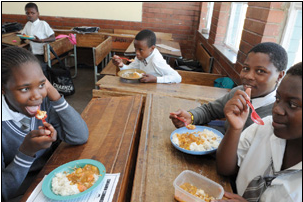 They are among the more than eight million learners across the country who are being fed at school each day thanks to a programme launched by former President Mandela during his term in office.
They are among the more than eight million learners across the country who are being fed at school each day thanks to a programme launched by former President Mandela during his term in office.
One hundred days after he took office, Madiba launched a number of development programmes to kick-start the Reconstruction and Development Programme (RDP).
The RDP’s main aim was to develop previously disadvantaged communities. The National School Nutrition Programme (NSNP) was one of those programmes.
Back then, there was a nutritional and educational crisis in South African schools, especially in rural areas where school attendance was low.
Now, nearly 20 years later, the face of the education system across the country has changed. To date, more than eight million learners in 21 467 public schools are now benefitting from the programme and more than 54 000 volunteers prepare and serve the meals daily.
The NSNP has been transformed from a simple cold meal to a daily hot meal. At selected schools it benefits all learners, not just the poorest.
The programme was expanded in 2009 to include secondary schools.
The grant for the programme has also increased by R266. 6 million in 2013/14 to R5.173 billion and the Department of Basic Education estimates that it will reach R5.704 billion in 2015/16. In Gauteng alone, the programme provided nutrition to 1 051 362 learners and in the past year it was successfully extended to all 1 256 no-fee schools in the province.
Feeding learners
One of these schools is Tane Primary, situated in a semi-rural area just outside Hammanskraal, north of Pretoria. About 900 of the 1 010 learners are at school early each morning, eager not only to get an education but, for some, their only meal of the day.
The learners make sure they are at school before 7am so that they can get their share of soft porridge in the morning.
Some days they arrive at school hungry.
“I sometimes get dizzy because I am hungry but the food allows me to concentrate in class so I can learn,” said one of the learners.
Volunteers who prepare the meals are the unemployed parents of learners.
Volunteer Helen Kekana, 33, said they arrive at the school as early as 6.30am to start preparing because the learners are always early.
“Raining or not, the children line up. The meals have improved their love for education and plays a big role in the way they perform,” said Kekana.
The school supplements its NSNP grant with a vegetable garden. This provides needy learners with food parcels and the children gain skills in growing crops.
Kekana says the programme has also created jobs. “Before this I was unemployed, but now I have a stipend of R840 which I can use to take care of my family.”
Principal George Maremo says the NSNP has had a positive impact on the lives of learners but there is still room for improvement.
“There has been an increase in the school attendance and concentration levels and the social and physical participation of learners in school-related activates has improved. Over the years, absenteeism has dropped.
“However, the programme also has a few areas where it can improve. For example, providing kitchen facilities and other equipment would go a long way and it will help us monitor the learners better,” he said.
Despite these glitches, the faces of learners at Tane Primary School beam the importance of this nutrition programme.
Don’t be fooled by bogus colleges
Don’t be fooled by bogus colleges sadminAs the 2014 academic year gets closer, the Department of Higher Education and Training (DHET) has warned students and parents to be careful of illegal or “fly-by-night” institutions.
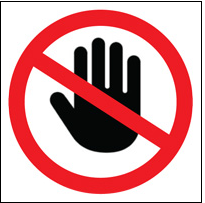 “Fly-by-night” institutions are not registered as institutions of learning with the correct Sector Education and Training Authority (Seta), DHET or other relevant bodies.
“Fly-by-night” institutions are not registered as institutions of learning with the correct Sector Education and Training Authority (Seta), DHET or other relevant bodies.
These institutions lure and mislead future students into believing these colleges are registered with bodies such as the South African Qualifications Authority (SAQA).
According to DHET’s Deputy Chief Education Specialist, Monica Motloi, these illegal institutions do not offer proper Qualifications.
“The impact of the ‘fly-by-night’ institutions in the education system is that the quality of education is being compromised and qualifications obtained are not recognised for employment purposes or studying further.”
Motloi said there had been some success in shutting down these operators.
“The number of colleges that are operating illegally has decreased tremendously over the years. The decrease can be attributed to the department’s awareness campaign in the print and electronic media and radio interviews.”
She added that the department was working closely with law enforcement agencies to close down these institutions.
How to check:
- Before enrolling with a private higher education institution, ask for evidence that the institution and its programmes are registered. This evidence is the certificate of registration and the registration number issued by the department.
- Before enrolling, make sure that the institution offers learning programmes and qualifications at the level at which you want to qualify.
- Before paying or entering into a contract, ask the DHET to confirm the registration status of the institution. Contact the department’s call centre on 0800 872 222.
- Claims by an institution that it is offering internationally recognised higher education programmes, while not registered to operate in South Africa, are misleading. Get the right information from the department.
- Be on the lookout for the fraudulent use of the names of world-renowned institutions by unscrupulous providers who use them for financial gain. Check the facts with the DHET.
- The registration of private FET colleges and private higher education institutions can also be checked on the department’s website www.dhet.gov.za
Making Gauteng schools crime-free zones
Making Gauteng schools crime-free zones sadminThe Gauteng Department of Education (GDE) is on a mission to make schools in the province safer.
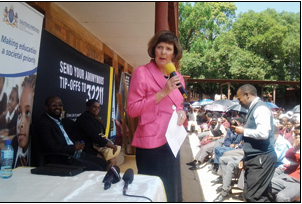 The GDE, working with the South African Police Service (SAPS), Crime Line and Lead SA, recently launched the Young Crime Liners initiative to tackle the increase in crime and social problems at the province’s schools.
The GDE, working with the South African Police Service (SAPS), Crime Line and Lead SA, recently launched the Young Crime Liners initiative to tackle the increase in crime and social problems at the province’s schools.
The schools face problems such as drug and alcohol abuse, vandalism of school property, gangsterism and bullying.
The initiative, launched at Mosupatsela Secondary School in Kagiso, will give learners tools to report crime and social issues anonymously. The aim is to root out criminal behaviour and tackle bullying and abuse.
Education MEC Barbara Creecy encouraged learners to pass on information to the police about criminal activities at schools.
“Members of the SAPS cannot be in every classroom in our schools. It is therefore important for you as learners to provide information so that we can root out crime in our schools,” she said.
Learners and members of the public can call Crime Stop on 08600 10111 with their anonymous tip-offs or send an SMS costing R1 to Crime Line on 32211.
To make schools safe and secure and help learners perform at their best, the GDE has also implemented the Extra School Support Programme.
This programme has resulted in 6 041 patrollers being appointed as security staff at 1 300 schools.
In addition, 1 408 schools have been linked to SAPS across the province and safety committees have been set up in each of the schools.
* Mathapelo Nhlapo works for the Gauteng Department of Education.
Farming cooperative paints Escourt green
Farming cooperative paints Escourt green sadminWhen Tshepo Moloi discovered he could not continue teaching because of poor health, he decided to pursue his second passion in life - farming.
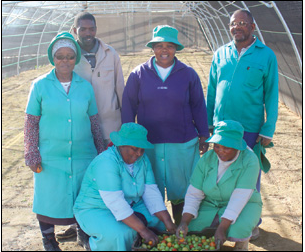 With no skills in farming, he teamed up with six members from his community in Escourt, KwaZulu-Natal, to form the Dlondlobala Agricultural Cooperative.
With no skills in farming, he teamed up with six members from his community in Escourt, KwaZulu-Natal, to form the Dlondlobala Agricultural Cooperative.
The group of four women and three men specialise in crop production and farming oyster mushrooms, which they supply to local supermarkets and the community.
The cooperative employs 47 people and had a turnover of about R180 000 last year.
“After leaving my teaching post I saw myself doing nothing along with some of my neighbours. I realised that I could have a second chance in life and also tap into the agricultural market,” says Moloi.
The group registered their business in 2008. Moloi says the next step was trying to get the business off the ground with limited funding and this was where the National Development Agency (NDA) stepped in.
The NDA gave the cooperative R1.8 million and with this grant they bought five tunnels used for farming and put in place a water irrigation system, facilities for the mushrooms to be grown in and electricity. The cooperative also approached the Umtshezi Municipality for land.
“We received the land and opted for the hydroponics method of farming,” Moloi recalls.
The cooperative chose hydroponics - where crops are grown with nutrients and water, without soil - as it yields more than farming in the soil.
With this method, pests and diseases are easier to get rid of because the crops are grown in a container.
“Even though we grow green pepper, potatoes, lettuce and tomatoes we still have a special interest in mushroom farming,” says Moloi.
“There was something different about farming mushroom, especially the technology involved that made us more interested in them,” he adds.
Moloi and his partners have big plans for the future.
“In the future we would like to see ourselves as fully fl edged business people and leading farmers,” he says.
Over the past 10 years the NDA has helped a number of cooperatives like Dlondlobala Agricultural, allocating over R1 billion to support communities through its programmes.
Chief Executive of the NDA Dr Vuyelwa Nhlapo said the agency had funded 44 food security projects, which encouraged communities to grow their own food products for private and commercial use, over the past three years.
N Cape revved up for land-speed record
N Cape revved up for land-speed record sadminAn attempt to break the world land-speed record is proving to be the perfect opportunity to put people to work in the Northern Cape.
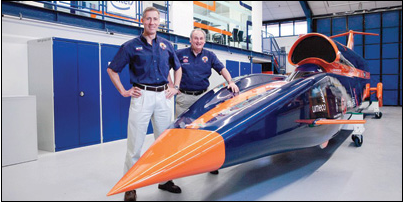 As part of the Expanded Public Works Programme (EPWP) the Northern Cape Department of Roads and Public Works has hired 317 people to clear the site on which British duo Richard Noble and Andy Green will race their car. Noble, an engineer and adventurer, has always dreamt of setting a world land-speed record. After realising this dream almost 29 years ago, Noble along with daredevil driver Green, is now on a mission to break their own record. Noble reached his record of 1 019km/h driving a turbo-powered car named Thrust2 across the Nevada desert, in the US, in 1983. In 1997, he built an improved car called ThrustSSC and managed to beat his previous record by reaching an impressive 1 228km/h. This remains the current world land-speed record but Noble and Green are now aiming to better it by reaching 1 609km/h. They are currently working on improving the car, which will be a blend of a race car and a jet fighter plane using spaceship technology. With two engines installed, the supersonic car, once completed, will have the same power as 180 Formula One cars.
As part of the Expanded Public Works Programme (EPWP) the Northern Cape Department of Roads and Public Works has hired 317 people to clear the site on which British duo Richard Noble and Andy Green will race their car. Noble, an engineer and adventurer, has always dreamt of setting a world land-speed record. After realising this dream almost 29 years ago, Noble along with daredevil driver Green, is now on a mission to break their own record. Noble reached his record of 1 019km/h driving a turbo-powered car named Thrust2 across the Nevada desert, in the US, in 1983. In 1997, he built an improved car called ThrustSSC and managed to beat his previous record by reaching an impressive 1 228km/h. This remains the current world land-speed record but Noble and Green are now aiming to better it by reaching 1 609km/h. They are currently working on improving the car, which will be a blend of a race car and a jet fighter plane using spaceship technology. With two engines installed, the supersonic car, once completed, will have the same power as 180 Formula One cars.
During its first test in the United Kingdom last October, the deafening sound of the car roared to that of five Boeing 747 planes taking off at the same time.
Finding a site to attempt the new record in 2016 was no easy task and after an extensive worldwide search using spaceshuttle radar data and satellite imagery, the team finally found the perfect spot - Hakskeenpan in the Northern Cape.
Hakskeenpan, situated 200km from Upington, is 16km long and flat and firm enough to support the car. Green, who is also a Royal Air Force pilot, will be the driving force behind the supersonic car.
To ensure the site is cleared and ready on time, the department of Roads and Public Works created work opportunities for unemployed community members from the neighbouring villages of Klein Mier, Groot Mier, Phialndersbron, Loubos and Rietfontein. The workers will clear the site of stones, pebbles and debris.
For Hendrik Kortman, this is the first time he has been employed in years. Kortman, who lost his legs in an accident a few years ago, does not let his disability get him down. Equipped with a spade and bucket he clears the track of cobbles and pebbles. With no family to help support him, Kortman says the money he earns will help him buy clothes and food.
“This job has given me hope. Government has given me the chance to have a better life,” he says.
The department has invested almost R7.5 million providing work opportunities for various communities, while at the same time creating the world’s best land-speed track.
“A bulldozer would have done this job within a short period of time but we deliberately chose to make it an EPWP project so that we could create job opportunities for our local communities,” said Northern Cape Roads and Public Works MEC Dawid Rooi.
Hats off for N Cape teen’s helmet design
Hats off for N Cape teen’s helmet design sadminEngineer Richard Noble and RAF pilot Andy Green have taken their passion for racing a step further by creating the Bloodhound Project- a global education initiative.
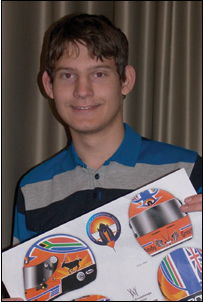 The project promotes the exciting use of technology, engineering and mathematics at schools and aims to inspire a future generation of engineers and technologists.
The project promotes the exciting use of technology, engineering and mathematics at schools and aims to inspire a future generation of engineers and technologists.
The Bloodhound Project has been introduced at over 5 000 schools in the United Kingdom (UK) with leaners being taught the fundamentals of combining engineering with science and technology.
Fifty schools in the Northern Cape have also introduced the Bloodhound Project into their classrooms and learners were given a chance to design the helmet that Green will sport while attempting to beat the world land-speed record.
Green will need two helmets for his attempt and 17-year-old Dirk Coetzee, from Adamantia High School in Kimberley, scooped the South African winning design.
The rules for the design were simple, says Green. All learners had to do was design a colourful helmet in the Bloodhound colours - orange and blue. From more than 1 000 entries, Coetzee’s bold design stood out.
“I love the bold and exciting South African theme of Dirk’s design, and the big sunrise and gemsbok adding a Northern Cape element,” said Green.
“It is a proudly South African design. It is perfect!” The other winning helmet came from 11-year-old Sam James from the UK.
N Cape honours transport’s driven women
N Cape honours transport’s driven women sadminIn the deep rural village of Pella Namakwa in the Northern Cape, residents struggled to get to shops and learners had to walk long distances to school.
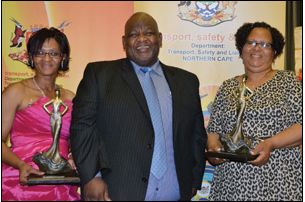 Access to public transport was a huge problem, until Lina Simboyia decided to do something about it. She bought a 15-seater taxi and ventured into a male dominated taxi industry, becoming the first female taxi driver in the area.
Access to public transport was a huge problem, until Lina Simboyia decided to do something about it. She bought a 15-seater taxi and ventured into a male dominated taxi industry, becoming the first female taxi driver in the area.
Fast forward 10 years later and Simboyia is now a successful taxi operator, the first female regional chairperson of the South African National Taxi Council (Santaco) and more recently, a winner in the Northern Cape Women in Transport Awards.
Simboyia won the Women Entrepreneurs in the Transport Industry category, which honours women who have demonstrated outstanding leadership, growth and development in their transport business.
“Not only is this a big victory for me, it is also a victory for the industry as a whole, especially for us women to be recognised,” said Simboyia.
The awards, an initiative of the Northern Cape Department of Transport, Safety and Liaison, highlight contributions and outstanding achievements made by women in transforming the province’s transport industry.
Simboyia said it was time women took charge of their future and ventured into male dominated industries.
She has also been instrumental in motivating women in her village to start their own businesses.
“I wanted to inspire other young women to take charge of their own future,” said Simboyia.
Apart from inspiring others, Simboyia is also empowering them, having hired five people so far.
Another woman making her mark in the province’s transport industry is Tanya Anders.
Anders, a traffic officer at the Britstown Provincial Traffic Office, won the Women with Best Outstanding Law Enforcement Role in the Transport Industry category.
The category recognised women who supported the transport industry in their law enforcement roles.
Anders is part of the Public Transport Inspectorate, a unit that is responsible for ensuring that public transport abides by the law.
She was rewarded for going beyond the call of duty by not only ensuring compliance in the public transport industry in her town, but in the neighbouring town of Carnarvon as well.
Anders said it was her job to remove unroadworthy vehicles from the roads and assist with taxi conflict.
“I also educate taxi drivers and operators on the National Land Transport Act, so they are aware of the rules and regulations they need to abide by,” she added.
Northern Cape Transport MEC Mac Jack said the awards promoted gender equality in the mainly male dominated transport industry and was aimed at encouraging women to pursue careers in the field.
“Without a doubt, this industry has been dominated by men for a very long time, but now women have arrived,” he said
Aredirisaneng Primary Cooperative wins big
Aredirisaneng Primary Cooperative wins big sadminFood and beverage company Nestlé gave some inspirational women a pat on the back and a healthy cash injection at the Nestlé Community Nutrition Awards recently.
The awards, which started 20 years ago, honour women who feed their families and communities from their food gardens.
According to Nestlé, the awards are a means for the company to support government and help with some initiatives.
Nestlé believes it has as much responsibility as government to create an environment that is conducive for people to thrive in.
One of the women honoured at the awards was Annah Matlala.
Matlala and her eight partners are part of the Aredirisaneng Primary Cooperative.
Based in Elandsfontein, in Gauteng, the cooperative encourages communities - especially women - to create their own food gardens and ensure food security for themselves.
The cooperative sells spinach and cabbage to the local Fruit and Veg City, President Hyper and the community.
“Our business is doing very well,” a proud Matlala said.
The Aredirisaneng Primary Cooperative walked away with a whopping R25 000 for the Best Female Project in the province during the awards.
The women of the cooperative came together in 2009 after they had a hard time finding jobs and were struggling to provide for their families.
In 2009, the cooperative approached the Department of Agriculture and was offered a six-month training programme in farming and business management.
“Once we had completed the training, the department facilitated a deal with the local Reunion Mine to help us start the business because at that time, we did not even have land to farm.”
Matlala said the mine bought them one hectare of land in Elandsfontein and also arranged more farming training for the women.
“In 2011 we registered the farm and it has been progressing very well. We would like to acquire more land to farm more crops.
“We are working in this farm to make money and feed our families but what is more important is that this business is what makes us happy. We also have a passion for farming.”
Matlala also said the partnership between government and Nestlé and Reunion Mine had made a great difference in their lives.
“We owe much of our success to government and Reunion Mine. The R25 000 we won from Nestlé will be ploughed back into the business.”
The Nestlé awards are also an extension of the company’s Creating Shared Value (CSV) business principle. This principle acknowledges that for a business to be successful in the long term it has to create value not only for its shareholders but also for the society where it operates.
In 2009, Nestlé South Africa expanded the awards to include a schools category. Many schools across the country have started food gardens as part of the National Schools Nutrition Programme in partnership with government.
The vegetables harvested from the gardens are used to create a balanced and nutritious meal for orphaned and vulnerable children in the schools. Through this category, Nestlé is encouraging schools, especially at primary school level, to continue improving their gardens.
Nestlé aims to help the schools make their gardens sustainable through the prize money.
Female farmer reaps the rewards of hard work
Female farmer reaps the rewards of hard work sadminTwenty years ago, working as an assistant nurse in a clinic, Dorcus Modise never thought she would be one day be an award-winning farmer.
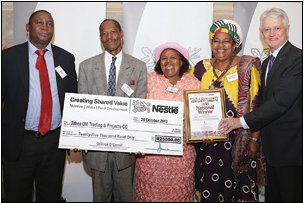 The 49-year-old, from Rankelenyane Village in Rustenburg, says it was democracy that opened the door for her to become a business owner and provide employment for people in her village.
The 49-year-old, from Rankelenyane Village in Rustenburg, says it was democracy that opened the door for her to become a business owner and provide employment for people in her village.
“I am so proud of this government. It has done so much for us. I am a farmer today because of this government. A lot has changed in the 20 years of democracy.
“As a woman I would not be where I am today if the former government was still in power. I am so proud of South Africa,” said Modise.
All those years ago, while working in the clinic, she had a burning desire to venture out on her own.
So in 1993, Modise and her husband, who was a teacher at the time, decided to open a tuckshop.
“We would buy vegetables from the local farmer and sell them to the community. As time went by we began to question why couldn’t we grow our own vegetables.”
The couple started small and formed a backyard garden in 1994. They also asked the local chief to allocate them land.
“We had to start this business with our own sweat because in those days there was not much that the government could do to help start up farmers.”
She eventually quit her job and decided to focus on the business.
“Between 2000 and 2007, things really began to look up for my business and it began expanding.
“The local chief gave us more land we now have five hectares that we work from. We started with only one hectare in our backyard.” During this period, she also attended workshops hosted by the Bojanala Platinum Municipality.
“This was when I realised that there was true potential in farming. I registered my business as Tabea DM Trading & Projects CC.”
She now grows spinach, oranges, tomatoes, and onions and will soon add peaches to her crops. She has 98 orange trees and employs 10 people.
Modise supplies her produce to Food Bank South Africa, Spar, three schools and the community.
Her efforts were rewarded in 2008 when she won the award for Backyard Female Farmer of the Year, which came with R50 000, from the North West Department of Agriculture.
“I used this money to buy a bakkie to transport my crops to buyers.”
Modise does not believe in waiting for government handouts, saying farming was her passion and it was up to her to make it a success.
“Farming is what makes me happy. It’s what I enjoy.”
Recently, Modise also won R50 000 at the Nestlé Community Nutrition Awards as the overall winner for the work she does. She said she would plough the money back into the business by fixing her water pump.
Her plans for the future include acquiring more land, planting more crops and assisting other start up farming business.
Frankfort villagers milking dairy job opportunities
Frankfort villagers milking dairy job opportunities sadminIn the small farming town of Frankfort in the Free State lies the rural village of Frankfort Savage – a small settlement of just 27 households.
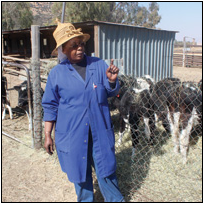 As you approach the town from the dusty gravel road that is surrounded by green grass and shrubs - an indication that the rainy season has arrived - you are greeted by red rooftops that peep from the mountains surrounding the village.
As you approach the town from the dusty gravel road that is surrounded by green grass and shrubs - an indication that the rainy season has arrived - you are greeted by red rooftops that peep from the mountains surrounding the village.
With the nearest town 36km away and the nearest city – Bloemfontein - about 150km, there is very little economic activity in the area. But the village is home to a small dairy farm called Assisi Farm, which is run by Sister Priscilla Katase, a nun based at the local Catholic Mission.
The mission also has a school, church and clinic, which service the village.
Sister Katase started the dairy farm to provide job opportunities for the community.
She says the farm originally belonged to the church and was scheduled to close down when the person running it immigrated to Germany in 2003.
“I had an interest in farming since my father was a farmer and I used to assist him. In 2003 I took over the farm and started the milking project.”
The farm has 54 milking cows and produces between 552 and 1 500 litres daily.
The milk is sold to Montic Dairy, the farm’s main client.
When Vuk’uzenzele visited the farm 22 cows were pregnant and there were 46 calves, which Sister Katase says, will help grow the business. The farm employs 13 villagers, mostly young people mentored by Sister Katase.
“When interacting with young people I noticed that they were not interested in farming. They associate working on a farm with being dirty without noticing the opportunities that this profession brings.
“I wanted to show them that farming could be as successful as any other profession. I think I am achieving this.”
During the tour of the farm, Sister Katase explains that a typical day at Assisi Farm starts at 4am when the cows are milked. The milk is then stored in a milking tank before being transported to Montic Dairy. The milk is collected every second day.
In 2011, Sister Katase received a financial boost from MTN.
“MTN gave me R100 000, which was used to buy feed for the cows. We plant and harvest mealies, which is also used to feed the cows. We also bought diesel for the tractor we use to harvest.”
Looking ahead, Sister Katase wants to venture into pasteurising the milk, which she believes will yield more opportunities for the small village of Frankfort Savage.
Bergville cooperative bakes its way to success
Bergville cooperative bakes its way to success sadminThulasizwe Shabalala was a newly qualified teacher when he left his job in 2011, after just two years, to start the Thuthukamzizi Bakery Cooperative with five other people.
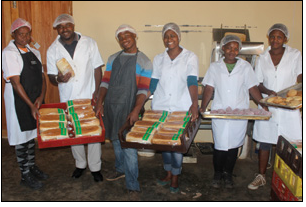 Shabalala says he always had a passion for the business world and decided to take a leap of faith by getting involved with the cooperative.
Shabalala says he always had a passion for the business world and decided to take a leap of faith by getting involved with the cooperative.
The Thuthukamzizi Bakery Cooperative, which is based in Emazizini, south of Bergville, KwaZulu Natal, was registered in 2009.
Members of the cooperative – Shabalala and five women - explored business ideas and the bakery was identified as the most promising.
They approached the Small Enterprise Development Agency (Seda) for help with their business plan and have not looked back since.
In 2010, the cooperative received a R250 000 grant from Old Mutual which was used to build the facility they work out of.
The building has five rooms, which include a baking area, storeroom, shop, office and conference room.
KZN Wildlife also supported the group by buying them bakery equipment, a container, borehole and electrifying the premises.
The KZN Department of Economic Development, Environment and Tourism arranged training and mentoring in baking for members of the cooperative.
In 2011, the cooperative applied for a grant from the National Development Agency (NDA) to buy baking machines and other equipment.
The application took about a year to process and was successful. The cooperative was granted R1.8 million, which would be allocated in phases.
Over the past five years the NDA has supported 50 projects in KwaZulu-Natal, spending about R77.7 million, according to NDA CEO Dr Vuyelwa Nhlapo.
So far, the Thuthukamzizi Bakery Cooperative received R850 000. This was used to buy a delivery truck, stock for the bakery, electricity upgrades and other machinery.
“When we started the cooperative we were working from a container we received from KZN Wildlife. The container is now being used as a tuckshop and is run by one of the members. She keeps the money which comes from the limited direct sales that takes place from the premises,” said Shabalala.
Besides bread, the cooperative also makes scones, muffins, rolls and biscuits.
Shabalala says the cooperative also sells soft drinks to the community and bread to the local school.
All of this takes hard work and the cooperative is busy throughout the day, working on a three-shift system.
“We supply local businesses such as B&Bs, hotels and tuckshops in the community. We started by making 600 loaves of bread per day and today the production has doubled.”
The cooperative employs 14 young people on a contract basis who receive a stipend from the NDA.
Shabalala says one of the cooperative’s biggest challenges is securing bigger contracts because they are competing with big companies.
He adds that their dream is for the business to be known throughout South Africa and expand to other areas such as growing and selling vegetables.
Thusano Fund gives youngsters a second chance
Thusano Fund gives youngsters a second chance sadminYouth matters
Puleng Molebatsi has had a difficult life but believes a better future is ahead of her after she received a bursary from the National Youth Development Agency (NYDA).
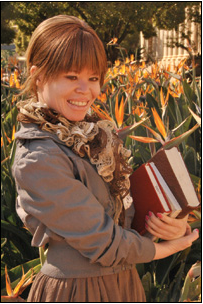 Molebatsi had to take on adult responsibilities after she lost her parents when she was just 14, leaving her to run the household.
Molebatsi had to take on adult responsibilities after she lost her parents when she was just 14, leaving her to run the household.
“From the age of 14 I had to cook, clean, do laundry and worry about electricity bills and food. It wasn’t easy but we survived due to the help of my teachers and community.”
Molebatsi lost her mother first, then her grandmother and aunt, leaving her to struggle to make ends meet as a teenager. She also had to raise two younger brothers and a cousin and has always dreamt of the day that she would be able to provide for her family.
Thanks to a student loan and hard work Molebatsi completed a Bachelor of Arts in Dramatic Arts degree at Wits University but despite her qualification she struggled to find a job and support her family.
She recently wrote to the NYDA requesting sponsorship for an English short course which would enable her to teach English to foreigners in South Africa or abroad.
Molebatsi was awarded a bursary from the NYDA to study teaching, majoring in English.
“I feel optimistic about my future again as I know there is a need for English language teachers in South Africa and abroad. I will do the NYDA proud for investing in my future and believing in me by working extra hard at finding a job before I complete my course,” she said.
Molebatsi, of Thabanchu in the Free State, is one of the beneficiaries of the Thusano Fund, which has been allocated R2 million from the agency’s annual budget.
Launched in April this year, the Thusano Fund is aimed at helping young people like Molebatsi, who approach the NYDA on a daily basis looking for financial help.
The fund grants a maximum of R50 000 per student.
NYDA Executive Chairperson Yershen Pillay said Molebatsi’s story was inspirational.
“I am deeply moved by Molebatsi’s story of determination despite all the hardships she has faced together with her family. She is a perfect example of how the NYDA is making a tangible difference in the lives of young people every day,” he said.
For more information on the Thusano Fund contact the NYDA on 0800 525 252
Thuthuka Fund helps churn out more accountants
Thuthuka Fund helps churn out more accountants sadminYouth matters
Becoming a chartered accountant (CA) was never part of Tokelo Sekese’s plans.
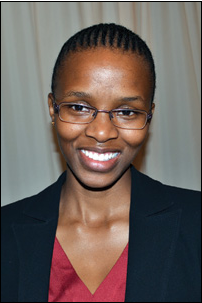 It was only after she found out about the Thuthuka Bursary Fund in her matric year that the idea to forge a career crunching numbers began to take shape.
It was only after she found out about the Thuthuka Bursary Fund in her matric year that the idea to forge a career crunching numbers began to take shape.
With a shortage of black CAs in the country, Sekese saw the fund as a means to help her make a difference in the industry.
The fund, created by the South African Institute of Chartered Accountants (SAICA), helps disadvantaged students realise their dreams of becoming CAs.
Sekese applied for Thuthuka funding in 2004, while completing her matric at Riverside High School in Vereeniging.
She received a bursary in 2005 to study Bachelor of Commerce (Accounting) at the University of Johannesburg. The bursary covered her accommodation, tuition, books, meals and included a living allowance and additional support programmes.
After graduating in 2008, Sekese completed her articles at Grant Thornton, where she worked for almost four years. Today, the 27 year-old is a successful CA at Investec.
“Without the Thuthuka Fund I would not be the well-rounded CA I am today. It provided me, not only with financial support, but I also had access to the best tutors and lecturers through the extra classes that we received.”
Sekese admits that she started her studies as a selfish, self-righteous teenager.
It was through the emotional and academic support she received through the fund that she became a hard working young woman, aware of her responsibilities with regards to transformation in the country.
“Today, I am a proud Thuthuka CA and I fl y the Thuthuka fl ag high,” she said.
About Thuthuka
The Thuthuka Bursary Fund was created in 2000 to address the shortage of African and Coloured CAs in the country. There are only 35 000 CAs in South Africa, of which only 2 700 are black (including Coloureds). Through the Thuthuka Bursary Fund, SAICA aims to develop almost 18 000 new CAs each year.
This year, the fund saw 1 000 learners studying accounting at universities across the country.
Thuthuka, which means ‘to develop’ in isiZulu, aims to develop young minds across the country, encourage learners to choose mathematics as a matric subject and highlight accountancy as a career choice.
SAICA also launched the Thuthuka Education Upliftment Fund (TEUF) to access and manage the funding needed for accountancy skills development programmes.
As part of the TEUF, various programmes have also been rolled out across the country. These include:
- The School Level Initiatives, which promotes chartered accountancy as a career option for learners from disadvantaged schools.
- Career promotion activities, exhibitions, presentations and symposiums that are conducted in all nine provinces.
- The Educator Workshops improve the skills of mathematics and accounting educators in schools through practical teaching methodologies.
- SAICA together with the provincial Departments of Basic Education, carry out Maths Development Camps for learners in Grades 11 and 12.
- Outreach Feeder Programmes run in partnership with universities, to provide supplementary classes in mathematics, English, science and accounting.
- Accounting and Maths Olympiads are carried out among 5 000 learners nationally. Together with the South African Mathematics Foundation (SAMF), the Olympiads are used to create awareness about the chartered accountancy profession to promising maths learners.
In an effort to ensure more learners have access to funding, government pledged a donation of R40 million to the fund earlier this year. Thuthuka usually requires about R40 million to recruit 400 new students each year. With the additional funding from government, the fund will be able to double its enrolment to 800 next year.
Accessing the Thuthuka Bursary Fund Learners can phone 08610 SAICA (72422) and ask for the Thuthuka Bursary Fund application form to be sent to them.
Completed application forms can be emailed to
saica@saica.co.za or posted to The Thuthuka Bursary Fund, PO Box 59875, Kengray, 2100. Learners can also visit the SAICA website www.saica.co.za for more information.
Domestic violence: what to do
Domestic violence: what to do sadmin16 Days of Activism
If you are in an abusive relationship or a child in your care is being abused, you can take steps to protect yourself or the child by approaching the courts. The Domestic Violence Act gives victims of domestic violence the maximum protection the law can provide.


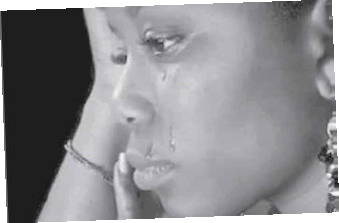
A step by step guide for victims of domestic violence:
1. The scene where abuse takes place
This could be the home of the complainant or a public or private space where an incident of abuse against the complainant takes place.
 2. Reporting the abuse
2. Reporting the abuse
- A complainant reports a domestic violence matter to the local police station. Victims may also approach the court, traditional leaders, prosecutors, religious leaders, social workers and non-governmental organisations working in their area.
- The police officer explains the procedure. The complainant has a choice to lodge a criminal case or application for a protection order, or both.
- If necessary, police will take the complainant to the doctor to assess any injuries as a result of the abuse. The assessment will be detailed in a form and could be used as evidence.
- After the assessment, the police officer refers the complainant to the local magistrate’s court to apply for a protection order.
3. The complainant is referred to the magistrate’s court
The clerk of the court will help the complainant complete an affidavit detailing the nature of the abuse.
- The clerk of the court will open a file and record it. The complainant must keep the file number issued safe.
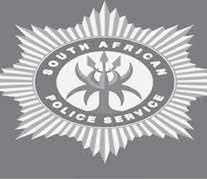 4. The magistrate considers the application
4. The magistrate considers the application
- The magistrate looks at the contents of the application and determines if the information is correct in the presence of the complainant.
- After careful consideration, the magistrate decides to issue an interim protection order and a date for a hearing.
- A warrant of arrest, which can only be acted on if the respondent violates the conditions of the interim protection order, is authorised by the magistrate and handed to the applicant by the clerk of the court.
5. Interim protection order is served on the respondent
- The interim protection order is served immediately by the police officer, sheriff or clerk of the court to the respondent. The date of the hearing will also be indicated.
 6. Court proceedings
6. Court proceedings
- The magistrate will check whether both the complainant and respondent are present and start proceedings.
- During the hearing both the complainant and respondent will have an opportunity to present their side of the story.
- The magistrate will then make a decision on whether to issue a final protection order.
- The complainant must be aware that the conditions of the final order may not be the same as those of the interim protection order.
- The conditions contained in the final protection order are permanent and can only be changed by a court of law.
7. Consequences of violating a final protection order
- If the final protection order is violated, the applicant must take the warrant of arrest and report the contravention to the police station.
- The respondent will be arrested and charged for violation of a protection order and prosecuted in the criminal court. If the respondent is found guilty he/she can be sentenced to a fine/ imprisonment or both.
What is domestic violence?
Domestic violence relates to any conduct that is harmful, or may cause harm to the safety, health or well being of the complainant.
This could be as a result of the following:
- physical abuse,
- sexual abuse,
- emotional, verbal and psychological abuse,
- economic abuse,
- intimidation,
- harassment,
- stalking or
- damage to property.
It may also include trespassing or entry into the complainant’s residence without consent and any other controlling or abusive behaviour.
A domestic violence case can be opened against:
- The person you are married to, whether by civil or customary rites.
- Your partner (whether of the same or opposite sex) who lives or has lived with you.
- The person you share parental responsibility with.
- People related to you by blood ties, marriage or adoption.
- The person you are engaged to, in a customary relationship with, or dating.
For more information contact: The Department of Justice and Constitutional Development. Postal Address: Private Bag X81 | www.justice.gov.za | Tel: 012 315 1111
Reclaimed land turns pain into prosperity
Reclaimed land turns pain into prosperity sadminBabanango is a land where the river fl ows, the birds sing and the mountains are green. Many have dubbed this place, nestled in Zululand, in the north of KwaZulu-Natal, little heaven.
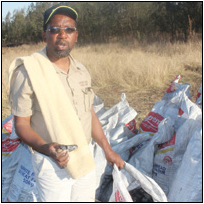 But all this majestic beauty is bittersweet because of the painful memory of how, in the 1950s, 192 families had to leave this land behind as part of apartheid’s forced removals.
But all this majestic beauty is bittersweet because of the painful memory of how, in the 1950s, 192 families had to leave this land behind as part of apartheid’s forced removals.
In 1997, these families, under the banner of the Emcakwini Community Trust, lodged a claim to get their land back.
Ten years later the land was handed over to the trust and the people of Babanango put the land to work, says the trust’s chairperson Eric Buthelezi.
“The community has now turned pain into prosperity by making sure that the 19 000 hectares of land is used to improve the community,” he adds.
According to Buthelezi, the trust had initially claimed 38 000 hectares of land but was granted 19 000.
The trust’s beneficiaries decided to make the most of the land and have set up lucrative, sustainable businesses such as farming, forestry, charcoal manufacturing and sew milling.
“All this comes with much hard work, determination and having a vision,” Buthelezi points out.
With all these businesses, the trust is the leading employer in Babanango, employing about 160 people from the community.
“Claiming land back is difficult but what is even more difficult is making use of that land and running a successful business. Numerous communities around South Africa receive land but aren’t able to use it to its full potential,” he explains.
Buthelezi worked at a museum in Pretoria but quit his job to focus on the trust and its land because he saw much potential there.
“I always wanted to become a farmer and to develop the land where I grew up.
“I did not want to see young people of this area leaving for urban areas seeking employment. I wanted the trust to be our bread and butter.”
When the trust received the land, most of the wattle, gum and pine trees on it were damaged.
“We decided to take the damaged trees and turn them into coal. This helped bring cash fl ow into our business and also made way to plant new trees where the damaged ones were.”
This gave birth to the trust’s charcoal business in 2008. To kick things off, the trust bought charcoal ovens needed to make charcoal.
The charcoal business employs about 24 people.
The process begins with cutting of trees, which are then placed in a charcoal oven for about 12 hours. After two days about 350 to 400 bags of charcoal are produced.
“We sell the charcoal to a company called Coastal Fires in Stanger. The agreement is to supply them as for as long as we can,” Buthelezi says.
The trust received R5 million from the National Development Agency (NDA) for their charcoal business.
The trust also produces crop and recently harvested 500 hectares of vegetables such as mealies and beans, which brought 20 employment opportunities.
In addition, there are two lodges on the land, one of which is operational.
“The owner of the Babanango Guest Lodges pays occupational rent to the trust and employs about 40 people. Our land is also rich in game. We have zebras, buck and impala which serve as a tourist attraction.”
The trust also has a sew milling plant, which produces beams used in houses. These beams are made from the trees on the land.
“The plant employs about 15 people from the community. We started this business last year and it’s doing very well,” says Buthelezi. He is hopeful that in the future land currently not in use will also be profitable.
“One day we hope to have a golf course, a spa as we have a spring fl owing from the Umfolozi River.”
Buthelezi’s ultimate aim is for the young people of Babanango to benefit from the trust’s initiatives.
“I want to step down eventually and see the young people of this land running the different businesses and seeing them prosper,” he adds.
Emcakwini Community Trust’s success is a testament to what South Africans, who have been victims of injustices in the past, can achieve under a democratic government.

- Since the start of the land restitution programme in 1995, 79 696 claims have been lodged.
- 77 334 of these claims have been settled.
- By the end of March this year, 4 860 farms had been transferred to black people and communities through the redistribution programme.
- About 250 000 people – more than 50 000 women, 32 000 youth and 674 persons with disabilities – have benefitted through land reform.
E Cape villages nuts about job creation
E Cape villages nuts about job creation sadminMembers of the rural community of Ncera in the Eastern Cape, south of East London, are rolling up their sleeves to earn a living.
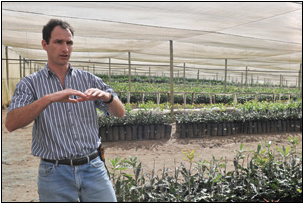 Back in 2005, the community of Ncera, which is made up of nine villages under the leadership Chieftainess Nobotwe Jongilanga, established the Vulindlela Development Trust.
Back in 2005, the community of Ncera, which is made up of nine villages under the leadership Chieftainess Nobotwe Jongilanga, established the Vulindlela Development Trust.
The trust manages a 300-hectare farm and grows macadamia nuts, which is used in chocolates.
Using the land at their disposal, the trust is creating jobs in Ncera and surrounding areas, developing sustainable black farmers, improving the living conditions of the locals and developing a world-class macadamia farm.
Managing director of Ncera Macadamia Farming Wayne Simpson said: “The Ncera plantations have created 90 permanent jobs and 14 seasonal jobs so far and are poised to create 400 jobs at full production.”
“This project has been good for the community of Ncera and having worked with them from the beginning, I have to say I am very proud of their progress and development. We hope to acquire more land to extend the project, and we are accessing all the help we can get to help us reach our goal.
“We recently joined the legends business support programme which is sponsored by Old Mutual, and it has been very helpful in terms of marketing support and dealing with some of the challenges we experience,” added Simpson.
Vulindlela Investment Trust owns 51 per cent of Ncera Macadamia Farming. The remaining 49 per cent is owned by private investors - Amadlelo Agri owns 23 per cent, Kula Macadamia 14 per cent and Nellfield owns 12 per cent.
Recently, the Department of Rural Development and Land Reform committed to help Ncera Macadamia Farming, with Minister Gugile Nkwinti pledging R36 million to the project.
This amount, he said, would be used for the construction of a 10.8km pipeline to supply the project with water.
Minister Nkwinti said he was impressed with the work done by the project since his last visit in 2006. He acknowledged the good model used there with ilima (where community members work together) and urged communities to lead government on initiatives.
Operations manager of Ncera Macadamia Farming Sthembele Dyasi said the project has made a positive contribution to the community.
Dyasi started on the farm as a general worker, pushing a wheelbarrow and worked his way up.
He said the farm had provided jobs for locals who had been unemployed.
SA, DRC talk business, energy
SA, DRC talk business, energy sadminInternational relations
South Africa and the Democratic Republic of Congo (DRC) are working together to generate clean energy from the Congo River.
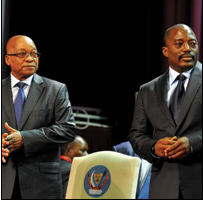 This follows the signing of the Grand Inga Treaty between President Jacob Zuma and DRC President Joseph Kabila to renew the Grand Inga Dam Project. The project has the potential to generate more than 41 000MW, which would be enough to supply electricity to half the African continent.
This follows the signing of the Grand Inga Treaty between President Jacob Zuma and DRC President Joseph Kabila to renew the Grand Inga Dam Project. The project has the potential to generate more than 41 000MW, which would be enough to supply electricity to half the African continent.
The treaty represents a practical commitment by the two countries to partner in developing this gigantic project that is expected to cost US$ 100 billion (R1 trillion).
“This agreement is significant since the Grand Inga Project has been in the pipe-line for a very long time. As South Africans, we are proud that we will be partnering with the people and the government of the DRC in the development of this project. The people of Congo deserve to celebrate this important milestone in their collective desire to develop and industrialise their country,” said President Zuma.
Land of opportunity
On the sidelines of the visit, a business delegation from South Africa attended a business forum with their Congolese counterparts. Among the South African companies represented at the forum were Vodacom, Standard Bank, Shoprite and Anglo Gold Ashanti.
According to the Department of International Relations and Cooperation (Dirco), President Zuma commended South African companies that had already invested in the DRC in the mining, telecommunications, financial services, road infrastructure, construction and hospitality sectors.
“Total South African investment in the DRC between 2006 and 2012 was estimated at R12.5 billion. Over 4 000 jobs were created from the investment projects,” said Dirco.
South Africa also contributed troops to the Intervention Brigade, which was mandated by the African Union and United Nations to confront armed groups in the eastern DRC. The brigade helped the DRC army defeat the main rebel group, M23, which has now signed a peace treaty with the government.
In their discussions, President Zuma and President Kabila expressed satisfaction with progress made in strengthening political and economic cooperation between the two countries.
Dirco said the two Presidents agreed to prioritise key areas of cooperation such as trade and investment, energy, infrastructure, agriculture, transport, science and technology, and security cooperation.
President Zuma also stressed the importance of intra-African trade.
“South Africa is looking to harness further opportunities by embarking on several projects that favour the promotion of value added products and services to the DRC and to give support to the DRC Government’s infrastructure and economic development initiatives,” he said.
President Zuma noted that economic growth in Africa and the DRC in particular, was expected to outpace that of developed countries.
“African growth rates will average six per cent in 2014. In comparison, growth in the developed world will average 3.6 per cent. The DRC is estimated to grow at 8.2 per cent in this year alone. Against this backdrop, any investor would be hard pressed to find higher rates of return elsewhere in the world. However intra-regional trade and sustained growth on the continent must be preceded by enabling technical and transport infrastructure,” he said.
President Zuma added that he was pleased with the outcome of the DRC visit.
“The outcomes of our discussions reaffirm our continued commitment and resolve to put our bilateral cooperation and partnership to higher levels,” he said.
President Zuma shares reconciliation lessons with Sri Lanka
President Zuma shares reconciliation lessons with Sri Lanka sadminInternational relations
President Jacob Zuma used his recent visit to Sri Lanka to share South Africa’s experience in national reconciliation.
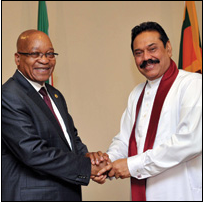 He was attending the Commonwealth Heads of State and Government Meeting (CHOGM) in Colombo, where he met with Sri Lankan President Mahinda Rajapaksa and the leadership of the Tamil National Alliance for bilateral talks on the sidelines of the three-day CHOGM meeting.
He was attending the Commonwealth Heads of State and Government Meeting (CHOGM) in Colombo, where he met with Sri Lankan President Mahinda Rajapaksa and the leadership of the Tamil National Alliance for bilateral talks on the sidelines of the three-day CHOGM meeting.
According to the Presidency, President Zuma discussed “the role that could be played by South Africa in assisting the people of Sri Lanka to resolve their problems through engagement”.
The Sri Lankan government is under international scrutiny for the conduct of the final stages of its military campaign against Tamil Tiger rebels, in which tens of thousands of civilians died.
The civil confl ict ended in 2009 after nearly three decades of fighting.
As many as 40 000 civilians were killed in the last months of the confl ict, as government troops advanced on the last stronghold of the Tamil Tiger rebels, fighting for an independent homeland.
President Zuma also participated in the dialogue between the Heads of State and youth leaders, which saw the establishment of the Commonwealth Youth Council. The council will ensure that youth matters are taken forward in an organised manner.
With regard to the United Nations’ Development Agenda after 2015, which was the theme of the summit, President Zuma recommended that countries must build on progress accomplished so far and take into account regional programmes.
“Poverty eradication, addressing income inequalities and job creation must remain the overarching objectives of the Development Agenda beyond 2015.”
According to President Zuma, the theme of the CHOGM meeting -- Growth with Equity: Inclusive Development - resonated very well with South Africa’s National Development Plan (NDP), which aims to eradicate poverty and inequality by 2030.
He urged Commonwealth leaders to continue championing the aspirations of the youth and ensure that their voice is represented in Commonwealth actions at national and international level.
Meanwhile, the leaders committed to work on post-2015 development, including debt financing and climate change.
The leaders also agreed that achieving growth with equity and inclusivity must be one of the main policy priorities for the Commonwealth. They reaffirmed the right to development for all individuals, and vowed to eliminate disparities and focus on making growth more inclusive for all, including for vulnerable groups, women, youth and the disabled.
The leaders also welcomed progress being made in strengthening relations between the G20 and Commonwealth members, including the establishment of the Annual Commonwealth Dialogue and regular G20 outreach with the Commonwealth.
Leaders further requested Commonwealth finance ministers to develop proposals for adoption at the Commonwealth Finance Ministers’ Meeting in 2014, which can further deepen the Commonwealth's engagement with the G20.
“Heads [of state] also acknowledged the work being done by the Commonwealth members of the Global Governance Group 3G in encouraging the G20 to engage the wider UN membership. They welcomed Australia's forthcoming assumption of the G20 presidency, and noted that this offers an important opportunity to refl ect Commonwealth priorities in advancing global development policy challenges,” they said.
SA’s sports stars shine at awards
SA’s sports stars shine at awards sadminIt was a night of glitz and glamour when the country’s sports heroes were honoured and rewarded during the 2013 South African Sports Awards recently.
 The sports-mad country recognised the hard work, dedication and record-breaking efforts of sportsmen and women in various sporting codes during the past year.
The sports-mad country recognised the hard work, dedication and record-breaking efforts of sportsmen and women in various sporting codes during the past year.
2013 saw the rise of many talented sports stars across the country such as wheelchair tennis champion, Lucas Sithole who recorded six victories across the globe and runner Mapaseka Makhanya who set a new record in her marathon debut.
It is these inspirational sporting achievements that capture the spirit of the South African Sports Awards, which were hosted by the South African Sports Confederation and Olympic Committee (SASCOC) and the Department of Sport and Recreation South Africa (SRSA).
“The beauty of sport is that you reap what you sow and when you put in the hard work it will pay off and because most of the hard work is done away from the spotlight, the early morning training sessions, the sacrifices, the strict diets and so on, we are so pleased that we are able to honour and celebrate individuals like Makhanya who are super achievers,” said SRSA Minister Fikile Mbalula.
Winners at the awards included:
Sports Star of the Year: Itumeleng Khune
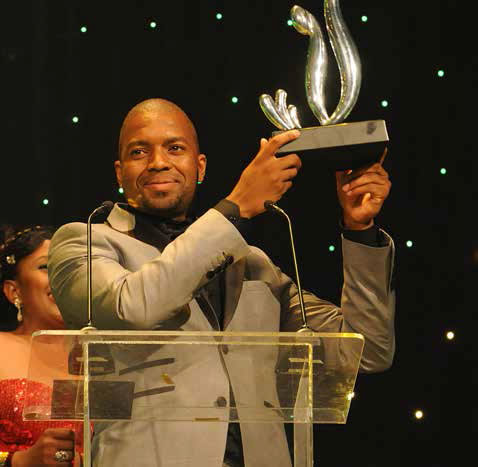 November was a busy month for the Kaizer Chiefs and Bafana Bafana captain Itumeleng Khune. From winning the coveted Sports Star of the Year Award to leading the national team that beat world champions Spain in a friendly, Khune is definitely in the middle of a fantastic career.
November was a busy month for the Kaizer Chiefs and Bafana Bafana captain Itumeleng Khune. From winning the coveted Sports Star of the Year Award to leading the national team that beat world champions Spain in a friendly, Khune is definitely in the middle of a fantastic career.
He walked away with a whopping R1 million prize and the keys to a brand new BMW. Social responsibility also ranks high with the ‘spider-kid’ as he is referred to by his fans, as he donated half his winnings to the Lechelemane Primary School.
“I think all of us sitting in this room are champions and we are all winners,” said Khune, after accepting his award.
Sportsman of the Year: Cameron van der Burgh
Swimmer Cameron van der Burgh is a world record holder and breaststroke champion.
 As Sportsman of the Year, he walked away with a cash prize of R130 000.
As Sportsman of the Year, he walked away with a cash prize of R130 000.
After winning the award, he took to Twitter to thank his fans. “Thank you so much for the messages everyone…Harder training, faster swimming... Hope to make you guys proud again in the future,” he Tweeted.
This year alone, Van Der Burgh scooped gold in the 50m breaststroke and silver in the 100m at the Fédération Internationale de Natation (FINA) Fina World Championships held in Barcelona recently.
His major achievements include representing South Africa at the 2008 and 2012 Olympics. At the 2012 event, he clinched gold in the 100m breaststroke, while setting a new world record.
Sportswoman of the Year: Mapaseka Makhanya
This year has been one for the books for distance runner Mapaseka Makhanya. Tired of living in the shadow of runner Caster Simenya for the past few seasons, she boosted her efforts and secured her spot as number one, snatching the top spot for both the 1 500m and 5 000m at the SA Senior championships in Stellenbosch earlier this year. Following these achievements on the track, she shifted her focus to road running and made history again by setting a new record in the Spar Women’s 10km Challenge and at the 2013 Gauteng Marathon. She also achieved global success by winning the 1 500m at an international event in Mauritius in April 2013 and was part of Team SA at the World Championships in Poland in March.
Sportsman of the Year with Disability: Lucas Sithole
2013 has been a good year for Lucas Sithole. First he was crowned South Africa’s Wheelchair Tennis champion and then he was named Sportsman of the Year with Disability for the second time.
Sithole is currently South Africa’s number one ranked player in the quad division and number two in the world. In just seven years he has secured a whopping 37 career titles, which bears testament to the champ’s winning spirit.
Sithole wants to inspire children to take up the sport.
“It is such a great sport and more effort should be placed on encouraging learners to start playing. I am living proof that nothing is impossible, that is why I try and fail, but never fail to try,” he said.
Sportswoman of the Year with Disability: Kgothatso montjane
At just 27, South Africa’s number one ranked wheelchair tennis player, Kgothatso Montjane already has many big tournament wins behind her name. Now she can add the title of Sportswoman of the Year with Disability for 2013. A force to be reckoned with on the court, she also has a degree in Recreation and Leisure from the University of Venda and is now studying Retail Business Management at the University of Johannesburg. Born with a congenital defect, she had her knee amputated at a young age. Off the court, she is also passionate about youth development and hopes to “work in the community, coaching sport and organising recreational activities”.
Other winners included:
Administrator of the Year: Mimi Mthwethwa – President Netball South Africa
Team of the Year: The Proteas - Cricket
Newcomer of the Year: Thato Tsomole – Tennis
Coach of the Year: Holger Losch - Tennis South Africa
Volunteer of the Year: Zakes Mkhize – Trialthon South Africa
Indigenous Games of the Year: Simphiwe Maphumulo – Mlabalaba
Federation of the Year: Swimming SA
Photographer of the Year: Wessel Oosthuizen
Journalist of the Year: Ramatsiyi Moholoa
Developing School Team of the Year: Daniye Primary School
School Team of the Year: Sol Plaatjie School
Recreational Bodies: Discovery 702 Walk the Talk
Each of these category winners received R 130 000 each in prize money.